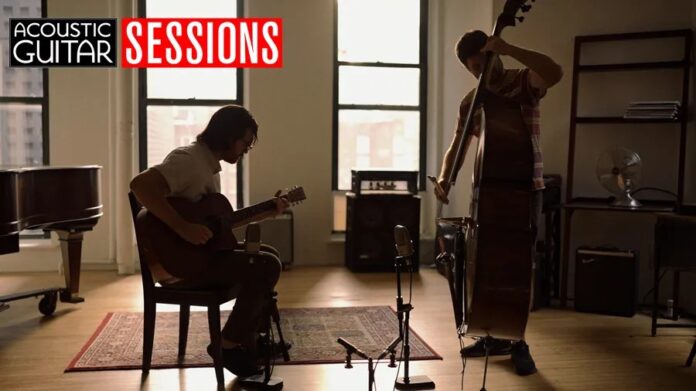The Elijah McLaughlin Ensemble has been described as a mix of American primitive guitar, jazz, and classical. The descriptor that popped up in my head while listening? Avant-folk shredding. However you label it, the trio’s music is larger and farther-reaching than the sum of its parts. All three members—McLaughlin, Jason Toth (upright bass), and Joel Styzens (hammered dulcimer)—are firing on all cylinders technically and creatively. The new record, Eljiah McLaughlin Ensemble II, explores a wide range of sonic and emotional territories; at times it sounds harmonious and soaring, at others frenetic and dissonant. It’s an album that is not only heard, but felt.
For this AG Sessions video, McLaughlin and Toth perform the songs “Effigy” and “Viroqua” from the new album. I caught up with McLaughlin over Zoom to talk about composing, improvising, and his C.F. Martin & Co. OMC-15E. -Joey Lusterman
Can you tell me a little bit about how you composed that first piece, “Effigy”?
It started with tuning. I was tuned to a D minor chord to learn this Skip James song, “Killing Floor Blues.” I was fascinated with the tonality that was achieved through the tuning. I started experimenting with a riff, and from that I developed the song just through improvisation. Then I brought it to Jason and we hammered out the arrangement. A lot of the methodology behind our recording is: things are written and we go and record them when they are fresh.
Do you improvise when recording and performing the piece, or just in the writing process?
Both really. It depends on the song, but usually I have an arrangement or a chord progression, and within that parameter of the arrangement, its good to keep things very loose and free. All the solos we recorded for ”Effigy” for example, were different. If you were to listen back to all the takes, of which there are four or five, the solos are different. Generally the same vibe, but different.
One thing I noticed was the dynamic range in terms of both composition and in the actual playing.
Certainly a huge part of the arc of any song. The solo section in this particular song was structured to be as intense as we could make it. We get louder, we speed up, we push the rhythm a bit, and then come off of that arc and cool things out a bit. Tension and release.
What is the guitar you are playing in the video?
A Martin OMC-15E. It’s a great guitar, I got it 12 years ago. I wanted a small-body orchestral model acoustic, I wanted a Martin, but I couldn’t really afford one. I came across this one on craigslist. The guy was selling it for very cheap, because it had a top that was lifting off the body and the bridge was barely hanging on. But I looked at it and thought, “this could be fixed.” It was dinged up, but there were no major structural cracks in the guitar. I decided to take a chance and I bought it.
When I brought it to a luthier in Chicago, he was like, “Hey man, has this guitar been underwater?” But he was able to re-glue the top and reinstall the bridge, and he did his magic and it plays really well now. I love this guitar; it’s and easy to play guitar and I like the comfort of the smaller body.
It’s got a very even tone. I’ve played dreadnoughts and other guitars that have much bigger, boomier sounds, but I like this guitar for fingerpicking and it just it does everything well. When I drop the tuning it sounds great. When I want the lower registers, they are there, but they aren’t booming or too loud.
How about the second tune, “Viroquoa”?
It’s about a small town in Wisconsin, sort of near the Mississippi River. I started going to that area with my dad a few years ago. Every summer we’d go there and go fly fishing in the streams that are offshoots of the Mississippi. It’s a really beautiful place. We’d rent this cabin in the middle of nowhere. It was nice and secluded, and had this big porch that looked over a creek. I wrote the riff for this song on that porch. I have a lot of positive memories of the family being there.
This Session was captured live at the Fine Arts Building Studio, Chicago.
Video: Jeff Perlman Audio: Caleb Willitz
Credit: Source link































